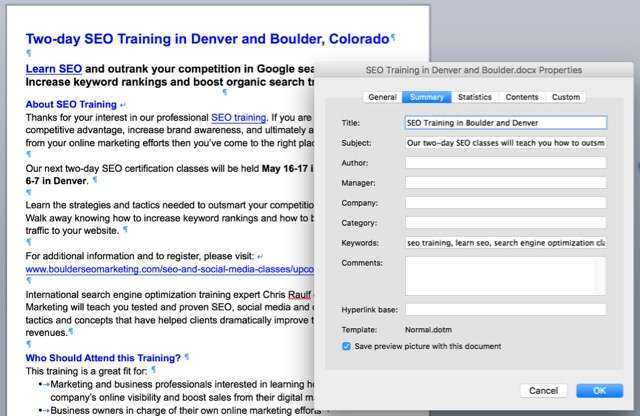Search engine optimization (SEO) is the process of increasing traffic to a website by applying best practices that help display your website in organic search results for target SEO keywords and phrases on search engines such as Google, Bing, and Yahoo. The higher up on the page you land in organic (aka natural or non-paid) search results, the more likely that people will click through to your website. Thus, the goal of optimizing a website for organic search is to increase website traffic that, in turn, converts visitors to customers or that helps them solve a problem so that they don’t have to call tech support.
Over the last five years or so, SEO has become very complex and also quite technical. Search engines continue to refine and evolve their algorithms to combat the so-called “black hat SEO strategies.” For additional information about the latest Google algorithm updates, make sure to read an article entitled How to Make BERT (Google’s Latest Algorithm Update) Your Best Friend.
Technical Writers Need to Understand the Basics of SEO
 Are you a technical writer? If so, have you heard of TCLoc? It’s a career-oriented Master’s program in Technical Communication and Localization from the Department of Languages at the University of Strasbourg, France. Specially designed for translators and technical writers who are looking to move their careers forward, the year-long, distance-learning master’s program is taught entirely in English by experts in the fields.
Are you a technical writer? If so, have you heard of TCLoc? It’s a career-oriented Master’s program in Technical Communication and Localization from the Department of Languages at the University of Strasbourg, France. Specially designed for translators and technical writers who are looking to move their careers forward, the year-long, distance-learning master’s program is taught entirely in English by experts in the fields.
It’s the first program in Europe to combine both a Master’s degree and an International Tekom Professional Level “Technical Communicator (tekom)” certificate. I’m very proud to be part of this program as I teach the content marketing and SEO portion of the course.
As part of the course, I teach students from all over the world how to apply SEO best practices into the content that they develop. From the feedback that I gather from theses students, sadly, technical writers and linguists are frequently not involved in the SEO efforts of a company. I find it quite ironic since these are the people that develop and translate the content that’s supposed to get found on Google and other search engines. Especially in larger companies, there seem to exist silos. The departments involved in developing content for the website don’t support each other when it comes to developing search-engine-optimized content. Succeeding with SEO depends on how well the various departments and teams interact with each other. It truly is a team effort.
Search Engine Optimization is a Team Effort
Successful search engine optimization requires a strong team that reflects:
- An SEO manager, who drives the process, assigns tasks to team members, analysis data, reports to management, etc.
- Content creators, who can develop the highest possible quality content that is also optimized for organic search.
- Linguists: SEO-aware linguists need to ensure that the target SEO keywords are not just translated but rather transcreated and adequately included in the translated content. Article International Search Engine Optimization: Transcreation is Key shares additional information and best practices about this topic.
- Social media experts, who can help promote content, attract new followers and perform online community management.
- A Webmaster, who can assist with web design and technical aspects of the overall SEO process.
Increase Sales and Reduce Costs with SEO
Since you most likely already provide product or service support content, applying SEO principles and best practices to it not only helps increase sales but also decreases customer service calls that produce more significant cost savings. Let’s say that the average cost of a customer support call at your company costs $30. By reducing the monthly call volume by 500 inbound calls, you could help save your company $15,000 every month.
So how can you get involved in this process? I recommend you start by focusing on the following six areas:
- Developing targeted marketing content
- Delivering content in the right format
- Reusing content in different formats
- Incorporating keywords into your content
- Creating searchable content
- Creating help systems optimized for online search
Let’s discuss these options in a bit more detail:
1. Developing Targeted Marketing Content
Inbound marketing involves creating high-quality content, applying SEO practices such as keyword research, and promoting the content using social media. As a technical communicator, you have a wealth of knowledge about your product and services, so you’re crucial to content marketing.
Good marketing content aims at solving problems and fostering interest–it’s not about selling. So start at the end: who is your audience? What kind of information do your customers need to know? What are the top customer support calls? What are some trends in your industry? Collaborate with your marketing team to see if there’s a content gap and how you can contribute.
2. Delivering Content in the Right Format for your Audience
After performing a content gap analysis, think about what formats are you using to deliver content, and the best ways to reach your audience. Content can be delivered in many ways, such as web pages, PDFs, eBooks, infographics, videos, help systems, social media postings, and more. Again, get involved and collaborate with your marketing team to come up with the best way to present information.
I recently had an experience where a YouTube video was beneficial to learn how to replace my garage door backup battery. I looked up the model and manufacturer, and I searched initially on Google. To my surprise, the manufacturer didn’t have useful information, or a short how-to video, on replacing a backup battery. Still, I found a YouTube video by a guy who had the same issue. So thanks to a YouTube video and not the manufacturer, I was able to replace my battery quickly. The manufacturer lost an opportunity to help and impress me.
Google, YouTube, Facebook, and LinkedIn are some of the most-used sites used to search for information. You can use all of these platforms and more to make content available, so think outside the box and always keep your customer and end-user in mind: Where are they searching for what kind of content?
3. Reusing Content
Look at all the great content that you provide in manuals. It’s probably not enough these days to keep this valuable information tucked away in a PDF that’s stored on your website because customers don’t want to spend time searching for information–they want and need quick results. Think about how you can bring this content to life in other ways, like videos or interactive graphics. For example, in addition to writing a troubleshooting process in a manual, perhaps an infographic would make an impactful addition.
4. Incorporating Keywords
Your SEO manager should have a list of scientifically researched keywords and phrases that you can use to incorporate into your inbound marketing content, website copy, meta tags, and support content. Make sure to get access to this keyword list.
5. Tips to Create Search-Engine-Optimized Content
Here are some tips on how to create optimized content for your website:
- Make sure that every web page has optimized meta tags. The title tag should be a short and precise description of what people can expect to read. Aim for 50 – 60 characters and make sure to include your main target SEO keyword for that page.
- The description tag should contain 150 – 160 characters and provide additional information about the page. Try to include one or two target SEO keywords.
- Although Google currently ignores the keywords tag, I’d still add three target keywords since other search engines still pay attention to this tag.
- Make sure that all of the Alt / Images tags contain an applicable target keyword or phrase.
- Blog posts should be at least 500 – 700 words long.
- In-depth and evergreen content needs to be at least 1,000+ words long.
- Press releases should be at least 400 – 500 words long.
- Try to include one internal hyperlink per 100 words and include at least one high-quality external link to a relevant website.
- Try to include keywords in H1, H2 and H3 headings.
- If possible, include your most important keyword in the first paragraph and a variation of that keyword in the last paragraph.
- Don’t forget to include a call to action.
Bonus tip: If you publish MS Word and other source format documents in PDF format to your site, make sure to fill out the title, subject and keywords property fields before PDFing the document; this will lend some additional “SEO-juice” to the documents:

6. Creating Help Systems and Help Content Optimized for Google Search
Having a help system for support information where customers can easily access, search, and download information on their own can dramatically reduce the costs of customer service calls. As mentioned earlier, by optimizing your help content so that people find it in online search, you’ll be able to reduce inbound calls to your tech support center dramatically. For larger companies, this usually translates into 1000s of dollars saved every day.
In a recent blog post entitled What webmasters should know about Google’s core updates, Google shares what content will perform well in their search engine results pages. It boils down to focusing on developing the highest quality content possible that helps your target audience solve an issue. Before drafting and publishing content to a website, Google recommends that you ask yourself the following questions about your content:
Content and quality questions
- Does the content provide original information, reporting, research, or analysis?
- Does the content provide a substantial, complete or comprehensive description of the topic?
- Does the content provide insightful analysis or interesting information that is beyond obvious?
- If the content draws on other sources, does it avoid simply copying or rewriting those sources and instead provide substantial additional value and originality?
- Does the headline and/or page title provide a descriptive, helpful summary of the content?
- Does the headline and/or page title avoid being exaggerating or shocking in nature?
- Is this the sort of page you’d want to bookmark, share with a friend, or recommend?
- Would you expect to see this content in or referenced by a printed magazine, encyclopedia or book?
Expertise questions
- Does the content present information in a way that makes you want to trust it, such as clear sourcing, evidence of the expertise involved, background about the author or the site that publishes it, such as through links to an author page or a site’s About page?
- If you researched the site producing the content, would you come away with an impression that it is well-trusted or widely-recognized as an authority on its topic?
- Is this content written by an expert or enthusiast who demonstrably knows the topic well?
- Is the content free from easily-verified factual errors?
- Would you feel comfortable trusting this content for issues relating to your money or your life?
Presentation and production questions
- Is the content free from spelling or stylistic issues?
- Was the content produced well, or does it appear sloppy or hastily produced?
- Is the content mass-produced by or outsourced to a large number of creators, or spread across a large network of sites, so that individual pages or sites don’t get as much attention or care?
- Does the content have an excessive amount of ads that distract from or interfere with the main content?
- Does content display well for mobile devices when viewed on them?
Comparative questions
- Does the content provide substantial value when compared to other pages in search results?
- Does the content seem to be serving the genuine interests of visitors to the site or does it seem to exist solely by someone attempting to guess what might rank well in search engines?
Before hitting the publish button, you may also want to run the newly developed content by someone outside of your company to get unbiased feedback. Don’t be shy to ask a customer to take a final look at the content. If you develop content frequently, it may be a good idea to have a pool of 5-10 customers who are willing to assist you in this matter.
The Tip Of the Iceberg
After incorporating some or all of the ways I’ve outlined to get involved with SEO, you want to make sure to see the results of your efforts. If you’re a technical writer, don’t be shy to ask the SEO manager to see the metrics or be involved in meetings to learn more. There’s so much more to search engine optimization, and I encourage you to continue the education process. We offer a variety of digital marketing SEO training courses, and I’d be happy to answer any questions you may have.
If you’re not sure if your business could benefit from search engine optimization, I invite you to use our free SEO audit tool. In less than a minute, the tool provides you with a comprehensive 8-page site audit report. I’ll be happy to discuss the findings of the report in a complimentary screen share meeting or phone call. Please don’t hesitate to reach out.
What’s Your SEO Score?
Enter the URL of any landing page or blog article and see how optimized it is for one keyword or phrase.
